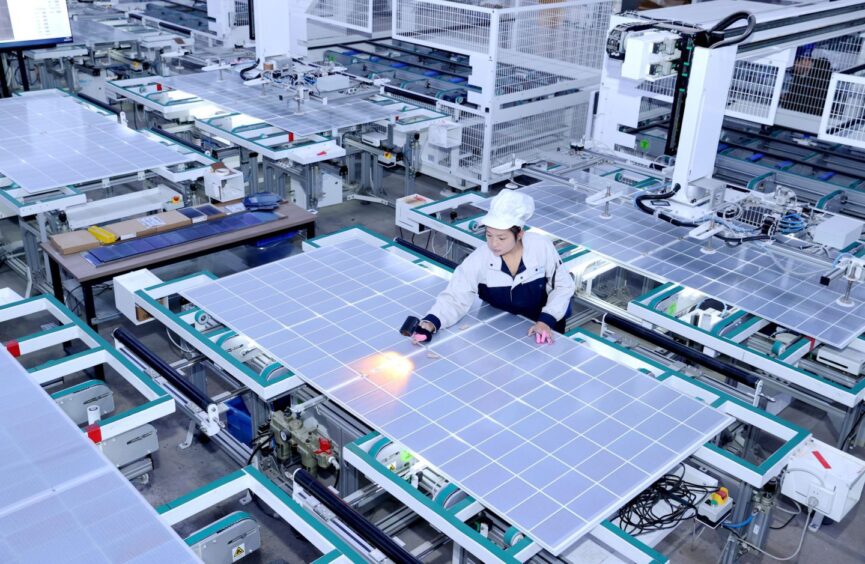
The solar energy harvesting market is expected to more than double in value within a decade, with one forecast suggesting sun power could account for at least half of all electricity in the UK by 2034.
Bifacial solar panels capable of capturing sunlight on both sides, advanced battery storage, decentralised systems, even floating solar farms, and analytics powered by artificial intelligence (AI), are all expected to enhance industry efficiencies.
The solar energy harvesting market is forecast to grow to $548.27 million by 2034, up from an estimated $248.27m of revenue in 2025, at a projected compound annual growth rate of more than 9.1%, according to a new report.
Asia Pacific is expected to drive much of that global growth, where the solar harvesting market is predicted to expand at a rapid rate of approximately 9.5% from now until 2034, driven by government incentives and innovation, the report by Fundamental Business Insights said.
Gareth Simkins, senior communications adviser at trade body Solar Energy UK, said: “Solar energy is cheap, green and rapidly deployable, so it is no wonder that it is growing so quickly around the world, whether on home roofs or at grid scale.
“Its benefits are only going to become more apparent as the technology progresses and the damaging impacts of climate change continue to become more evident.
“Although any prediction should be treated with caution, expectations of geometric growth are eminently reasonable, especially given how the solar industry has regularly outshone previous forecasts.”
The solar energy harvesting market encompasses photovoltaics, concentrated solar power and thermal technologies, as well as consumer electronics, wireless sensor networks, and power management integrated circuits. The report noted an “upsurge” in the use of solar as a source of power for electric vehicles.
Growth of the UK solar market has been supported by the Smart Export Guarantee, launched in 2020, while in the US market, the decreasing cost of solar panels combined with tax credits, rebates and net metering have driven expansion.
‘Analysts have been wrong’
According to another new projection made this month, more than half of global energy demand will be met by solar power in just a decade.
Physicist Andrew Birch has argued that the clean energy transition can more accurately be predicted using an “s-curve” model that projects current trends into the future.
“On current growth trends, solar is on track to displace 50% of traditional energy supply within a decade—this should scare you if you’re still financing coal, oil or gas,” said Birch, who co-founded solar companies Sungevity and OpenSolar.
He has challenged former solar power modelling forecasts, claiming that a flawed equation has been used in the past where the metric of primary energy only applies to fossil fuels.
“Year after year, analysts have been wrong,” said Birch. “Solar’s learning curve has never ended, in fact, its growth rate has increased. When you combine this growth trend with the lower energy needed with electrification you get a solar-dominated system within just 10 years.”
Simkins agreed that previous models have historically “kept underestimating growth to a ridiculous extent” in the solar industry.
The International Energy Agency (IEA), which estimated in October that the share of wind and solar PV in the global electricity generation mix will double to 30% by 2030, has been accused of underpredicting solar and wind installations in its World Energy Outlook in the past.
More than half of the energy produced by traditional energy sources is wasted when burned, according to this latest research, which suggests that the s-curve model accounts for actual energy delivered.
Birch, in collaboration with Professor Andrew Crossland at Durham University Energy Institute, also projects that the cost of solar power will continue to come down in price.
S-curve modelling suggests future declines in the cost of solar power of 10% per year and growth of 25% per year in deployment.
Under these conditions solar could eclipse oil by 2031, overtake nuclear this year, and deliver more than half the world’s energy by 2035 in what Birch and Crossland described as a “classic s-curve technology shift”.
This growth is expected to be driven by rising demand for renewable energy, as a result of the energy transition, together with policy and financial incentives.
“We’ve been told a clean transition will cripple the economy, when in fact, it will save us $9 trillion dollars a year by 2035,” said Birch. “All we need is a level playing field. Just watch how quickly dirty fuels die in a fair fight when we stop the subsidies and remove clean tech tariffs.”
Recommended for you

